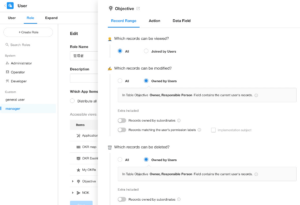
One of the biggest challenges in enterprise software development projects is the disconnect between those who understand the technology and those who are familiar with the business processes. Bridging this gap requires significant communication efforts from the project team. Sometimes, even with these efforts, the resulting applications have low usability or even fail completely.
To address this issue, APaaS platforms take the approach of empowering business experts with no-code application development capabilities. By lowering the barrier of software knowledge, these platforms enable business requirements to be expressed directly by those familiar with the domain, eliminating the need for complex cross-disciplinary communication.
The rationale behind this approach is simple. It is relatively easier for professionals from various industries to grasp the fundamental principles of software architecture than for software developers to learn the intricacies of every business domain.
Under this strategy, the core users of APaaS include professionals from the software industry such as product managers, project managers, and implementation specialists, as well as business professionals familiar with business processes across different sectors. For the former group, who already possess some basic skills in the software industry, the main challenge lies in understanding the clients’ business objectives and processes. On the other hand, non-software professionals need to overcome certain software architecture knowledge gaps.
This guide aims to address this topic. What essential software architecture knowledge do non-technical personnel need to design and build high-quality enterprise applications? This knowledge framework is not as complex as one might imagine, and I do not encourage business experts to spend too much time delving into software technology. Therefore, I have distilled the two most important aspects, including identifying business objects correctly and understanding workflow principles. If business experts possess these knowledge domains, they will undoubtedly play a crucial role in their organizations’ digital transformation efforts.
Identifying Business Objects and Creating Rational Worksheet Structures
Business objects refer to entities that need to be managed in business operations, including, at times, personnel. The key to correctly identifying business objects lies in identifying the uniformity of entities. While orders and invoices are related, they represent different entities in business activities. Similarly, while large and small customers are managed by different departments, their nature remains the same, with the size being just one of their attributes, albeit a variable one.
Once this basic criterion is established, efforts can be made to decompose various elements in management activities. Common business objects in enterprise applications include customers, contacts, suppliers, employees, projects, purchase orders, sales orders, products, price lists, and so on.
In zero-code products, the starting point is usually the establishment of business objects, referred to as worksheets on Nocoly HAP, which are named in line with the worksheets in Excel software.
When creating worksheets and their structures, the following approach can be followed:
- Create multiple worksheets that are non-repetitive and comprehensive for business objects in business processes. However, worksheets should not be created for statistical and summarization purposes, as the latter can be achieved through views and statistical functions of worksheets.
- Create worksheet fields based on the different attributes of business objects through controls. Refer to the introduction of various field types of worksheets. The number of fields should be based on necessity, reducing fields that are difficult to fill in and unnecessary for the business.
- Establish associations between worksheets using the “related table” control, allowing a field to directly select values from other worksheets. For example, selecting customer records from the customer table in an order.
- Reference other fields of related records using the “related fields” control. Note that without related tables, the “related fields” control cannot be used. Additionally, related fields are dynamically associated, meaning changes in the referenced table records will affect the referencing table records. Therefore, it is not suitable for static scenarios, such as the price field of a product table in a sales order table, as prices may change in the future but should not affect historical prices in sales orders.
- Dynamically calculate a value through formula fields, which can involve calculations across worksheets. Note that this is also dynamically associated and unsuitable for scenarios requiring static records.
Common Misconceptions in Creating Worksheet Structures:
- Establishing fragmented worksheets without necessary associations between them. For example, orders and customers are related data, although customer information may also be listed in orders, they should not exist in isolation within orders.
- Avoid creating scattered worksheets for the same business object based on different attributes. For example, while the customer table is an integrated worksheet, creating worksheets separately for major customers, minor customers, and Shanghai customers would lose necessary integration, making it difficult for business data sharing and integrated management.
- Creating worksheets for statistical and summarization purposes. For example, while worksheets for customer and order details are correct, “Weekly Order Report” is a report rather than original data and should not be created as a worksheet, as it provides limited informational value.
Understanding and Applying Workflow Principles
After establishing a sound data architecture, we need to operationalize business activities, relying on both user-driven actions, such as salespeople using the system to draft electronic quotes, and workflow engines to automate business processes. Automated workflows not only significantly improve operational efficiency but also create customer experiences that are difficult to achieve manually.
So, what are the underlying principles of automated workflows? We can summarize it with the name of a well-known internet service—IFTTT (If This, Then That). If this represents the trigger of the workflow, then that represents the action. Once the trigger conditions are met, the workflow automatically executes a predefined series of actions. Even the most complex workflows are based on this trigger-action combination.
This basic principle is not difficult to understand. Once this concept is established, business professionals can easily envision some immediate operational automation designs. For example:
- Sending a reminder message to the responsible sales manager a month before the expiration of an old customer’s contract.
- Generating a quotation document in PDF format based on customer category and industry selection, and emailing it to the customer upon clicking the “Generate Quote” button.
- Automatically generating a performance evaluation form for an employee two weeks before the end of their probation period and sending it to the corresponding manager for completion according to management arrangements. Once all forms are completed, they are sent to the HR supervisor.
- Automatically creating an invoice application for customer payment when the project status changes to “delivered.”
Such business process automation requirements are widespread across various industries. Before the advent of no-code application platforms, these tasks either had to be done manually or required expensive custom software development. Now, with user-friendly workflow tools, non-developers can achieve automation independently.
In summary, workflow triggers mainly fall into two categories: time triggers, such as examples 1 and 3, and data change triggers, such as example 4. For flexibility, workflows can also be triggered manually (by clicking a button), such as example 2.
On the Nocoly HAP application platform, application administrators can create an unlimited number of workflows. Once the workflow has been tested and published, it replaces manual labor and runs automatically without interruption. Each run leaves a historical record for reference. You must be curious how it works. Why not register for a free Nocoly HAP account and experience it yourself?



